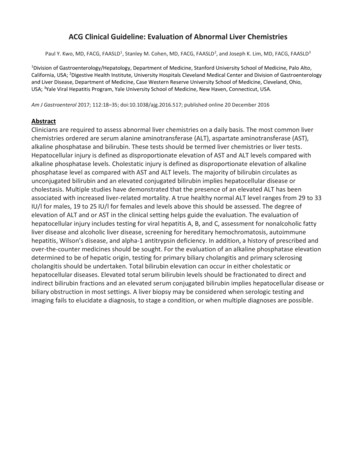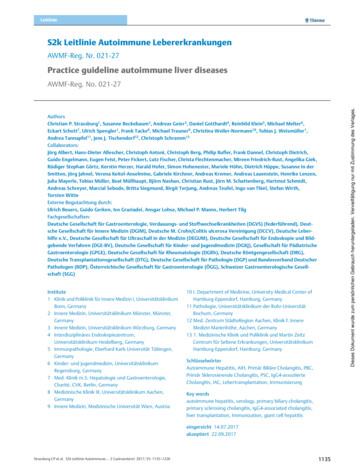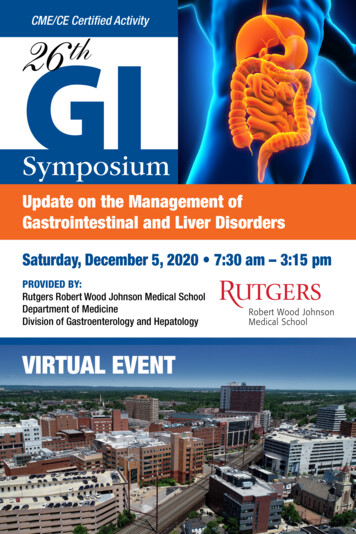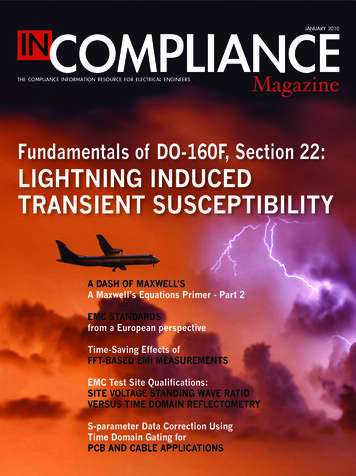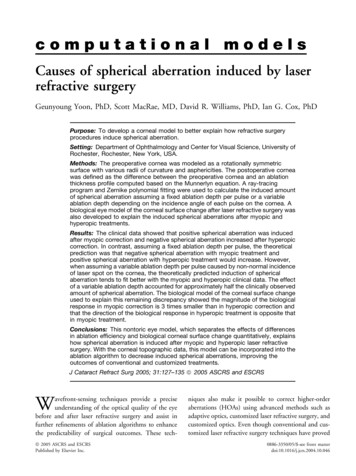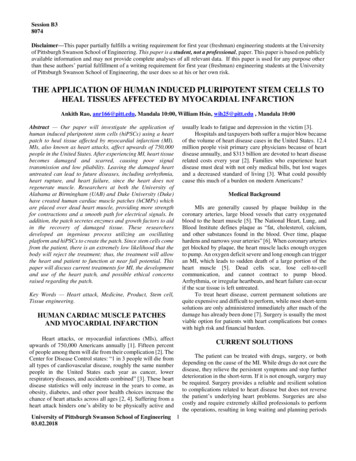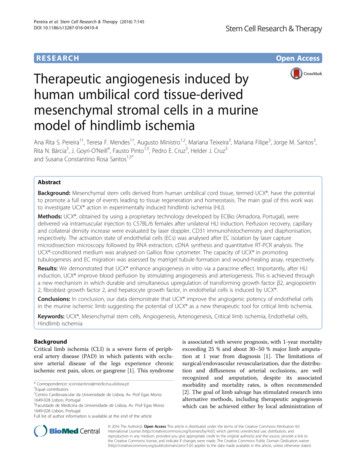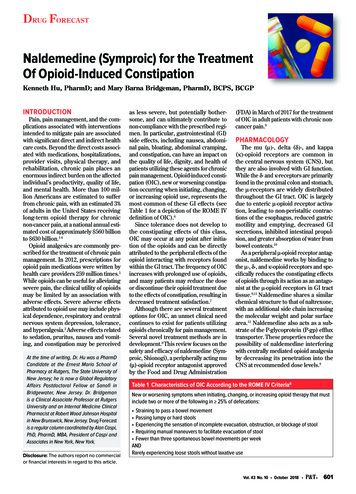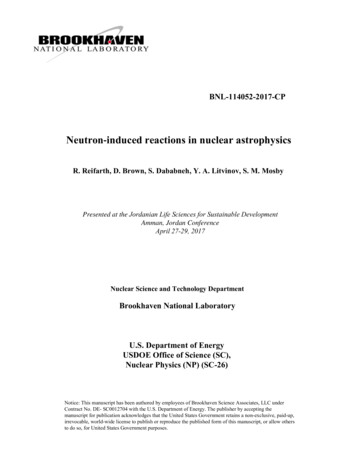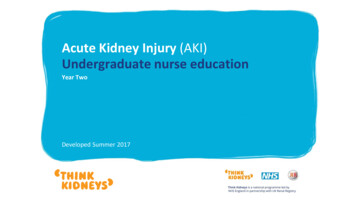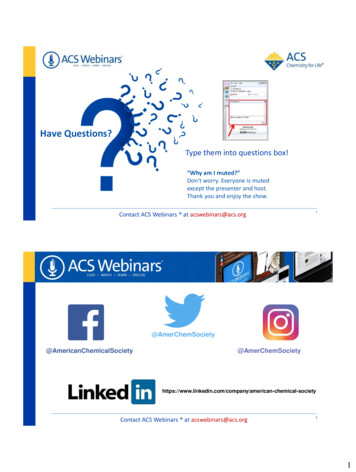
Transcription
Have Questions?Type them into questions box!“Why am I muted?”Don’t worry. Everyone is mutedexcept the presenter and host.Thank you and enjoy the show.Contact ACS Webinars at /company/american-chemical-societyContact ACS Webinars at acswebinars@acs.org21
Check out the ACS Webinar Library!An ACS member exclusive benefitHundreds of presentations from the best and brightest minds that chemistry has to offer are available to you on-demand.The Library is divided into 6 different sections to help you more easily find what you are ebinars/videos.html3Learn from the best and brightest minds in chemistry! Hundreds of webinars ondiverse topics presented by experts in the chemical sciences and enterprise.Edited Recordings are an exclusive ACS member benefit and are made availableonce the recording has been edited and posted.Live Broadcasts of ACS Webinars continue to be available to the general publicseveral times a week generally from 2-3pm ET!A collection of the best recordings from the ACS Webinars Library will be broadcaston Fridays from 2-3pm ET!www.acs.org/acswebinars42
What is ACS on Campus?ACS visits campuses across the world offering FREE seminars on how to be published, find a job, networkand use essential tools like SciFinder. ACS on Campus presents seminars and workshops focused on how to:5http://acsoncampus.acs.orgYOUR CAREERChemIDPTMChemIDP.orgWITH CHEMISTS ANDOTHER SCIENCEPROFESSIONALSACS PUBLICATIONSPublishing ResourcesCAS SciFinder Future Leaders171 alumni, 35 countriesand over 120 ources63
7ACS Career Navigator:Your Home for Career ServicesWhether you are just starting your journey, transitioning jobs, or looking to brush up or learn newskills, the ACS Career Navigator has the resources to point you in the right direction.We have a collection of career resources to support you during this global pandemic:ProfessionalEducationChemIDPVirtual CareerConsultantsCollege to CareerACS LeadershipDevelopment SystemACS WebinarsVisit www.ACS.org/COVID19-Network to learn more!Career Navigator LIVE!Virtual Classrooms84
Free ACS Webinars Every Week!Upcoming org9105
Join the Division Today!For 25 membership ( 10 for students), You Will Receive: A free digital copy of our annual medicinal chemistryreview volume (over 680 pages, 160 retail price) Abstracts of MEDI programming at national meetings Access to student travel grants and fellowshipsFind out more about the ACS MEDI Division! www.acsmedchem.org11Join the Division Today!Interact with over 1,300 fellow scientists boundby a strong interest in Chemical Toxicology.Elevate your professional profile. Our divisionis small enough for you to make an immediateimpact.Keep up with the latest research in ourprofession.The mission of the Division is to improve human health and public welfare by promotingthe understanding of chemical mechanisms that govern disease processes and the toxicityof drugs, environmental agents, and endogenous chemicals.http://www.acschemtox.org126
Catch up on 2020’s Free Open Access Recordings!Join Angela Zhou, an Information Scientist at CAS, as she provides an overview ofpublished scientific information relevant to COVID-19 research with an emphasison patents in the CAS content collection. g-discovery/covid-19.htmlJoin Research Fellow Li Di of Pfizer as she discusses why design principles thatincrease passive permeability are effective approaches to increase oralbioavailability, enhance brain penetration, and reduce renal in Douglas Kell, Research Chair in Systems Biology at the University ofLiverpool to discover how drugs pass through cell membrane solely byhitchhiking on membrane transporters and why so-called “passive diffusion”through any bilayer in real cells is S ACS WEBINAR WILL BEGIN SHORTLY.7
Mitigating Drug-Induced Liver Injury 2: Assessing Transporter Liabilities and Bioactivation TranscriptomicsMichael HafeyWen KangJames MonroePrincipal Scientist, MerckDirector of Assay Development, MerckSenior Principal Scientist, MerckKaushik MitraDirector, Department of Drug Metabolism andPharmacokinetics; DMPK Therapeutic Area Lead,Cardiovascular and Metabolic Diseases; Head,Biotransformation Sciences, Janssen Research & DevelopmentPresentation slides are available now! Edited recordings are an exclusive ACS member benefit.www.acs.org/acswebinarsThis ACS Webinar is co-produced with the ACS Division of Chemical Toxicology, ACS Division of Medicinal Chemistry, American Association of Pharmaceutical Scientists, and ACS Publications.Audience Survey QuestionANSWER THE QUESTION ON BLUE SCREEN IN ONE MOMENTWhat is your current experience with Drug-Induced Liver Injury (DILI)? I’m a medicinal chemist and encounter DILI in my drugdiscovery and design research I’m a clinician and observe DILI in my patients I’m a patient and have been personally affected by DILI Other (let us know in the questions panel)8
A two-tiered in vitro approach to de-risk drugcandidates for potential bile salt export pumpinhibition liabilities in drug discoveryHafey et al. (2020). DMD. 48:1147-1160.Michael HafeyTransporters & In Vitro TechnologiesPPDMMerck & Co., Inc.Learning Objectives Identify key hepatic transporters involved in bile acid disposition Understand the correlation between BSEP inhibition and DILI risk Learn how to utilize a two-tiered in vitro approach to limit compoundsthat may inhibit BSEP in vivo from reaching the clinic9
Outline Hepatic bile salt transport and the DILI BSEP decision tree Vesicular Inhibition Assay Experimental background and study design Example data set Hepatopac Transporter Inhibition Assay Advantages Experimental background and study design Example data set ConclusionsDrug Induced Liver Injury (DILI) DILI has been the most frequent single cause of safetyrelated drug marketing withdrawals for the past 50 years. Evidence for DILI often only emerges in late clinicaldevelopment or post-marketing. The causes of DILI are poorly understood and arepotentially multifactorial. There is no single assay available to derisk for DILI at thepreclinical stage. Instead, a battery of assays is used witha ‘weight of evidence’ assessment.Disruption of hepatic transport proteins involved inbile salt transport could contribute to DILI.Sistare et al. (2016). ILAR J. 57:186-211.10
Hepatic Transporters Involved in Bile Salt Transport The entero-hepatic circulation of bile salts is complex. BSEP mediated efflux represents the driving force forgeneration of bile flow and is the rate limiting step inoverall bile salt transport. Interference with the efflux of bile salts fromhepatocytes could cause intracellular accumulation ofbile salts leading to toxicity. Recent studies have shown that several drugsimplicated in drug induced liver injury (DILI) inhibitBSEP.Yang et al. (2013). J Pharm Sci. 102:3037–3057.Rodrigues et al. (2014). DMD. 42: 566-74.Kenna et al. (2018). CPT. 104:916–932.Bile Salt Transport Inhibition and DILI Objectives Understand the correlation between inhibition of liver transporters involved in bile acidtransport and human DILI risk. Establish in vitro assay systems to measure the effect of test compounds on bile salttransport. Approaches Study inhibition of BSEP, MRP2, MRP3, and MRP4 in vesicles by a test set of 120DILI and DILI- compounds. Develop and characterize a holistic TCA transport inhibition model in a long-termhuman hepatocyte micropatterned co-culture model (Hepatopac).11
3-Point Screen for BSEP Inhibition(allows for early spot checking of potential SARliabilities and path to screen out liability as needed )BSEP Vesicular Inhibition AssayIf IC50 5mM or 1/IC50 below target unbound Iin,maxempirical cutoff, considered low risk. (If IC50 5mMconsider MPCCs)Lead OptimizationTesting for DILI Potential via Transport Inhibition MechanismsDetermine BSEP IC50 for Single Candidates- Consider MPCCs when IC50 5mM or 1/IC50 abovetarget unbound Iin,max empirical cutoffHepatopac TCA Inhibition AssayIC50 BEI in MPCCs 10-fold fu*Iin,maxRisk is lowIC50 BEI in MPCCs 10-fold fu*Iin,maxPotential to inhibit BSEP invivo; Consider SAR to reduceliability or clinical monitoringfor cholestasisOutline Hepatic bile salt transport and the DILI BSEP decision tree Vesicular Inhibition Assay Experimental background and study design Example data set Hepatopac Transporter Inhibition Assay Advantages Experimental background and study design Example data set Conclusions12
Vesicular Transport Inhibition Assay Membrane vesicles isolated from Sf9 cells containing BSEP. Uptake transport by inside-out vesicles is driven by ATP. For inhibition study, transport of a probe substrate (taurocholic acid) is measured inthe presence of potential inhibitors. Answers the question: “Does compound X inhibit BSEP in vitro?”MK-8666 inhibits BSEP in membrane vesiclesAB454035302520151050ATPATP 0.00[3H] TCA Transport(pmoles/mg/min)[3H] TCA Transport(pmoles/mg/min)Inhibition of 1 mM [3H] TCAmediated uptake into BSEP vesicles51015% Control0.100.301.003.0010.0020.00 MK-8666 inhibited hBSEP-mediated[3H]TCA uptake with an IC50 0.79 0.08μM. 100 μM Atorvastatin completely abolishedBSEP-mediated [3H] TCA uptake,confirming the functionality of the assay.IC50 0.8 0.08 mM0ATPATP MK-8666 [mM]Inhibition of 1 mM [3H] TCAmediated uptake into BSEP 00.00100.00Atorvastatin [mM]CInhibition of 1 mM [3H] TCAmediated uptake into BSEP vesicles2025MK-8666 [mM]13
Combining liver inlet drug levels and human BSEP inhibitionpotency to assess clinical DILI risk potentialApproximate location of MK-8666 The orange line represents an empiricallydrawn cutoff.(1/IC50 1.3; Fu*Iin,max range from 0.03 – 0.15 µM) Inhibition of BSEP may be predictive ofhuman DILI for compounds that fallabove the line. Inhibition of BSEP is not thought to bepredictive of human DILI for compoundsthat fall below the line.Fu*Iin,max fu * (Imax (Fa * Dose * ka/Qh))Combining liver inlet drug levels and human BSEP inhibitionpotency to assess clinical DILI risk potential The empirical cutoff line for BSEP inhibition is represented by the equation:(Log10 (1/[BSEP IC50]) 0.87) * (2 Log10 ([Fu* Iin,max µM])) 0.1where 0.1 is defined as the “BSEP burden” If the BSEP burden for a compound is 0.1, the compound falls above theempirical cutoff line.Fu 0.002Dose (mg)Cmax (µM)Fu 0.0150Dose (mg)10Cmax (µM)5010FuFu Iin,max (µM)0.0020.03FuFu Iin,max (µM)0.010.15IC50 (µM)0.79IC50 (µM)0.79BSEP Burden0.47BSEP Burden1.1514
Combination of BSEP, MRP2, MRP3, and MRP4 Inhibition DataDILI NegativeDILI PositiveBSEP MRP2 MRP3 MRP4BSEP MRP2 MRP3 MRP4Under empirical cut offAbove empirical cut offObservations A compound positive for BSEP,regardless of inhibition of MRPs, may bea DILI risk. Inhibition of MRP2-4 alone lowered thepositive predictive value of the assay ascompared with BSEP alone because itincreased the number of false positives. MRP2–4 inhibition in addition toinhibition of BSEP decreased the overallspecificity of DILI predictions because italso increased the number of falsepositives.Outline Hepatic bile salt transport and the DILI BSEP decision tree Vesicular Inhibition Assay Experimental background and study design Example data set Hepatopac Transporter Inhibition Assay Advantages Experimental background and study design Example data set Conclusions15
Advantages of a More Holistic Transporter System: HepatopacKhetani and Bhatia. (2008). Nature Biotechnology. 26:120-126. When assessing the potential for transporter mediated cholestasis, testing inhibition ofeach transporter in isolation in vitro may provide a limited view of what occurs in vivo. Using a hepatocyte based system may be a more advantageous approach to examinethe effects of drugs on bile salt transport. Hepatopac is a bioengineered microliver platform which serves as a functional modelof the liver in vivo. Micropatterned plates contain tiny colonies of organized hepatocytessurrounded by supportive 3T3 fibroblasts.CDF Accumulation in Bile Canaliculi andLocalization of MRP2 and BSEP in HepatopacCDF* UptakeMRP2 LocalizationBSEP Localization*5(and 6)-carboxy-2’, 7’dichlorofluoresceinGreen, BSEP; Red, MRP2; Blue, Nuclei16
Typical Transporter Experiment inHepatopac SystemCryopreservedhuman hepatocytesand stromal cells areplated in co-culture.Hepatocytes form bilecanaliculiCells are preincubated withinhibitors in HBSSbuffer /- calcium forgiven timeCells are washed andincubated in HBSSbuffer containingradiolabeled substrate( /- inhibitors)Cells are washed,lysed, and counted byliquid scintillationcountingWolf et al. (2010). Toxicologyin Vitro. 24: 297-309.Calculations and Data InterpretationAccumulationcells bile - AccumulationcellsBEI (Efflux)X 100Accumulationcells bileAccumulationcells bile - AccumulationcellsIn Vitro CLbiliary (Uptake Efflux)In VitroClbiliaryAUCmediumBEIData Interpretation Sinusoidal uptake pathway affectedSinusoidal uptake and canalicular effluxpathways affected Canalicular efflux pathway affected17
QuestionDo known inhibitors of BSEP cause a decrease in BEIin a more holistic system such as Hepatopac?Experimental DesignInhibitorpretreatment /- Ca bufferInhibitor TCAaddedCells lysedandcounted0min10minInhibitor TCAaddedCells tin mediaInhibitorpretreatment /- Ca buffer-24hours-10min In Vitro Clbiliary and BEI calculated for 10 min and 24 hrs pre-trea
19.11.2020 · Merck & Co., Inc. Hafey et al. (2020). DMD. 48:1147-1160. Learning Objectives Identify key hepatic transporters involved in bile acid disposition Understand the correlation between BSEP inhibition and DILI risk Learn how to utilize a two-tiered in vitro approach to limit compounds that may inhibit BSEP in vivo from reaching the clinic


